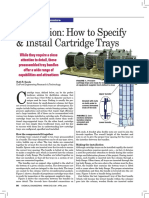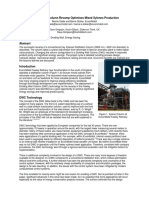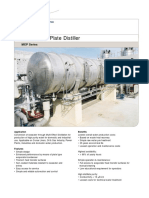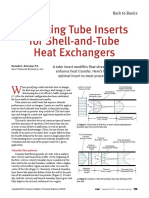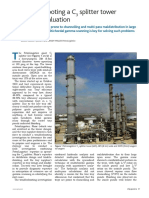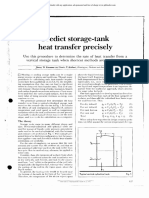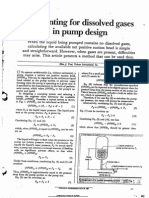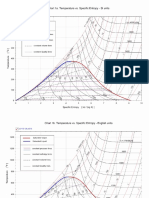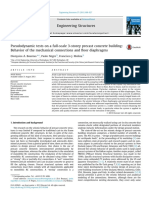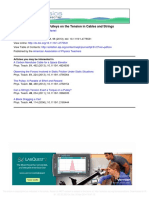Taitel and Dukler Horizontal Models
Taitel and Dukler Horizontal Models
Uploaded by
Ali SultanCopyright:
Available Formats
Taitel and Dukler Horizontal Models
Taitel and Dukler Horizontal Models
Uploaded by
Ali SultanOriginal Title
Copyright
Available Formats
Share this document
Did you find this document useful?
Is this content inappropriate?
Copyright:
Available Formats
Taitel and Dukler Horizontal Models
Taitel and Dukler Horizontal Models
Uploaded by
Ali SultanCopyright:
Available Formats
LITERATURE CITED Kobayashi, H., F. Arai, and T.
Chiba, “Behaviour of Bubbles
in Gas-Solid Fluidized Bed,” Kagaku Kogaku (Eng. Edi-
Davidson, J. F., and D. Harrison, Fluidized Particles, Cam- tion), 4,147 (1966).
bridge Univ. Press, Cambridge, England ( 1963). Kunii, D., and 0. Levenspiel, “Bubbling Bed Model. Model for
Fryer, C., “Fluidized Bed Reactors-Behaviour and Design,” Flow of Gas through a Fluidized Bed,” Ind. Eng. C h .
Ph.D. thesis, Monash University, Australia ( 1974). Fundamentals, 7,446 ( 1968) .
., and 0. E. Potter, “Countercurrent Backmixing Modd Latham, R. L., C. J. Hamilton, and 0. E. Potter, “Backmixing
for Fluidized Bed Catalytic Reactors. Applicability of Sim- and Chemical Reaction in Fluidised Beds,” Brit. Chem.
ed Solutions,” Ind. Eng. Chem. Fundamentals, 11, 338 Eng., 13,666 ( 1968).
$7:2a ). Perry, J. H., Chemical Engineers’ Handbook, 3 ed., McGraw-
, “Bubble Size Variation in Two-Phase Models Hill, New York ( 1950) .
of Fluidized Bed Reactors,” Powder Technol., 6, 317 Potter, 0. E., “Mixing,” in Fluidization, Chapt. 7, J. F. David-
(1972b). son and D. Harrison, ed., Academic Press, London (1971).
, “Fluidized Bed Reactor Performance--An Ex-
perimental Study of the Countercurrent Backmixing Model,” Schugerl, K., Discussion in PTOC. Internat. Symp. on Fluidiza-
PTOC. Internut. Symp. on Fluidization and its Applications, tion and its Applications, Toulouse, (Oct., 1973). Ste.
Toulouse (Oct., 1973). Ste. Chimie Industrielle, page 440 Chimie Industrielle, page 712 ( 1974).
(1974). Stephens, G. K., R. J. Sinclair, and 0. E. Potter, Powder
Harrison, D., and L. S. Leung, “Bubble Formation at an Ori- Technol., 1, 61 ( 1967).
fice in a Fluidised Bed,” Trans. Inst. Chem. Engrs., 39, 409 Whitehead, A. B., and A. D. Young, “Fluidization Per-
(1961). formance in Large-Scale Equipment,” Proc. Internut. Symp.
Kato, K., and C. Y. Wen, “Bubble Assemblage Model for Fluid- on Fluidization, Eindhoven (June, 1967). A. A. Drinken-
ized Bed Catalytic Reactors,” Chem. Eng. Sci., 24, 1351 burg, ed., page 284, Netherlands University Press, Amster-
(1969). dam ( 1967).
A Model for Predicting Flow Regime
-I ransitions 0 - 0
Horizonta I and Near
Horizontal Gas-liquid Flow
YEMADA TAITEL
Models are presented for determining flow regime transitions in two-
and
phase gas-liquid flow. The mechanisms for transition are based on physical A. E. DUKLER
concepts and are fully predictive in that no flow regime
” transitions are
used ;n their developme&. A generalized flow regime map based on this Deportment of Chemicol Engineering
theory is presented. University of Houston
Houston, Texos 77004
SCOPE
F’redicting the flow regime for concurrent gas liquid strongly on the particular data being used to prepare
flow in pipes has been a central unresolved problem in the map. For this reason extension to other conditions
two-phase flow. The usual approach has been to collect of pipe size or inclination, fluid properties, and flow rates
data for flow rates and fluid properties and to visually are of uncertain reliability.
observe the flow pattern through a transparent test section This work has the objective of presenting a means for
window. Then a search is undertaken for a way to map unambiguous analytical prediction of the transition be-
the data in a two-dimensional plot by locating transition tween flow regimes based on physically realistic mecha-
nisms for these transitions. The regimes considered are
boundaries between the regimes. This requires a decision intermittent (slug and plug), stratified smooth, stratified
to be made about the coordinates which are used. Be- wavy, dispersed bubble, and annular-annular dispersed
cause no theoretical basis for selection of coordinates has liquid flow. The theory predicts the effect on transition
existed in the past, this approach represents a coordina- boundaries of pipe size, fluid properties, and angle of
tion of the data rather then a correlation and depends inclination.
CONCLUSIONS AND SIGNIFICANCE
A theoretical model is developed which predicts the for transition are based on physical concepts and are
relationship between the following variables at which fully predictive in that no flow regime data are used in
flow regime transitions take place: gas and liquid mass their development.
flow rates: properties of the fluids, pipe diameter, and Five basic flow regimes are considered. When the
angle of inclination to the horizontal. The mechanisms theory is solved in dimensionless form the following
AlChE Journal (Vol. 22, No. 1) January, 1976 Page 47
Annular dispersed liquid to intermittent X, Y
and to dispersed bubble
The theoretically located transition boundaries for Y =
0 (horizontal tube) are shown as a generalized two-dimen-
sional map in Figure 4. Similar maps can be developed
simply for any other value of Y by using hand calculations
from the equations and graphical results given in the
paper. Figure 5 shows that the agreement between these
theoretical predictions and the latest available maps in
which the predictions are located from the data is very
good.
A parametric study was executed for the effect of
operating variables on the regime boundaries in a two-
K =F
DUL'
[y ] = F [Re~"]'h
%
dimensional map having as coordinates the superficial
velocity of the gas and liquid. With this method of map-
ping, the boundaries are relatively insensitive to pipe
All of these quantities can be determined from operating
diameter for an air-water system at low pressure and
conditions, since velocities and pressure gradients are
small line sizes. However, large shifts in location of some
calculated from superficial conditions.
of the boundaries take place for larger line sizes, for
The particular transitions are shown to be controlled
gases at high pressure, and for slight inclinations from
by the following groups:
the horizontal. The new generalized map, such as Figure
Stratified to annular x,F , y 4, does account for all of these operational factors and
Stratified to intermittent x
7 F, y thus should permit the prediction of flow regime with
Intermittent to dispersed bubble x,T,y confidence at conditions other than those determined in
Stratified smooth to stratified wavy x,K , y laboratory experiments.
The earliest and perhaps the most durable of regime Hubbard, 1975). Annular dispersed liquid flow represents
maps for two-phase gas-liquid flow was proposed by the condition described in the past of annular or semian-
Baker (1954). Many have been suggested (White and nular with various degrees of liquid entrainment ranging
Huntington, 1955; Govier and Omer, 1962; Kosterin, between very small and large amounts of dispersed liquid.
1949). Al-Sheikh et al. ( 1970) defined a variety of dimen- The process of analyzing the transitions between flow
sionless groups and using the Dukler two-phase flow data regimes starts from the condition of stratified flow. The ap-
bank evaluated the suitability of various pairs for mapping proach is to visualize a stratified liquid and then do deter-
the flow regimes. They concluded that no two groups mine the mechanism by which a change from qtratified
characterized all of the transitions and all of the data. flow can be expected to take place, as well as the flow
Recently a mapping based on coordinates of superficial pattern that can be expected to result from the change.
gas and liquid velocity has been constructed from a larger In many cases stratified flow is seen to actually exist in the
data base (Mandhane et al., 1974). entry region of the pipe. However, the fact that stratified
Part of the problem arises from the lack of precision flow may not actually exist is not important, since it is well
in describing these visual observations. There have been established that the existence of a specific flow pattern at
innumerable classifications suggested, such as smooth strat- specified gas and liquid rates is independent of the path
ified, wavy, semiannular, bubble, annular, froth, dispersed used to arrive at that state.
bubble, dispersed liquid, plug, and slug flow, among Since the condition of stratified flow is central to this
others. Hubbard and Dukler (1966), based on studies of analysis, the initial step is the development of a general-
the spectral distribution of wall pressure fluctuations, sug- ized relationship for stratified flows.
gested that each observation represents the superposition Equilibrium Stratified Flow
of three basic patterns: separated, intermittent, and dis-
tributed flow. However, the concept does not discriminate Consider smooth, equilibrium stratified flow as shown
between stratified and annular flow, or between the dis- in Figure 1. A momentum balance on each phase yieds
persed liquid or dispersed gas flow regimes, and these are
differences of considerable practical concern.
In this work a mechanistic model is developed for the
unambiguous analytical prediction of transition between
flow regimes. This approach also provides considerable in-
sight into the mechanisms of the transitions.
THEORY
The analysis which follows considers the conditions for
transition between five basic flow regimes: (SS) smooth
stratified, (SW) wavy stratified, (I) intermittent (slug and
plug), (AD) annular with dispersed liquid, and (DB)dis-
persed bubble. No distinction is made between slug, plug,
or elongated bubble flows, all being considered different
conditions of the intermittent flow regime (Dukler and Fig. 1. Equilibrium stratified flow.
Page 48 January, 1976 AlChE Journal (Vol. 22, No. 1)
I
-
hL -4Y=O (7)
D
where
x 2 =
D
(8)
.=[-I (dP/dx)s
( dP/ dx :1
" Y= (PL - p c ) g sin = -
- (PL - P d g sin
I (dP/dX) G'1
Q
Fig. 2. Equilibrium liquid level for stratified flow (turbulent liquid, (9)
turbulent or laminar gas).
I (dP/dx) designates the pressure drop of one phase flow-
- AG (9)
- T ~ - ~iSj
~ +
~sina = 0
SPGAG (2)
ing alone in the pipe. Thus, X is recognized as the parame-
ter introduced by Lockhart and Martinelli (1949) and can
be calculated unambiguously with the knowledge of flow
rates, fluid properties, and tube diameter. Y is zero for
Equating pressure drop in the two phases and assuming
horizontal tubes and represents the relative forces acting
that at transition conditions the hydraulic gradient in the
on the liquid in the flow direction due to gravity and pres-
liquid is negligible, gives the following results
sure drop. It too can be calculated directly. All dimension-
less variables with the superscript
hL/D, as can be seen from
- depend only on hL =
CI
+ (PL - PC) g sina = 0 (3) -
AL = 0.25 [m
-
- COS-~ ( 2 h -
~ 1)
The shear stresses are evaluated in a conventional manner
- ui) + (2LL - 1)4- (2hL - 1)2]
-
TWL =fL 2
PLUL~
TWG = fG -
PCUC2
2
Ti = fi
PC (UG
2 -= -- (10)
AG 0.25 [COS-' ( 2 h ~ 1)
(4)
with the liquid and gas friction factors evaluated from
CI
- ( 2 h-
~ 1) 4- (2zL- 1)2] (11)
c CI
= 7r - cos-1 (2hL - 1 )
where DL and DG are the hydraulic diameter evaluated in
SL
CI
SG = cos-1 (2hL
-- 1)
(12)
(13)
the manner as suggested by Agrawal et al. (1973) :
This implies that the wall resistance of the liquid is simi-
lar to that for open-channel flow and that of the gas to
-=
UG
C I -
A/AG (16)
closed-duct flow. It has been established that for smooth
stratified flow, fi N f~ (Gazley, 1949). Even though many Thus, each X-Y pair corresponds to a unique value of hL/D
of the transitions considered here take place in stratified for all conditions of pipe size, fluid properties, flow rate,
flow with a wavy interface, the error incurred by making and pipe inclinations for which stratified flow exists. The
this assumption is small. At flow rate conditions, where solution of Equation (7) has been executed for turbulent
transitions are observed to take place, u G >> ui. Thus, the flow of both phases, which is clearly the case of greatest
gas side interfacial shear stress is evaluated with the same practical interest ( n = m = 0.2, CG = CL = 0.046). The
equation as the gas wall shear. In this work the following results are shown as the solid curves in Figure 2 . Other
coefficients were utilized: CG = C L = 0.046, n = m = 0.2 situations may be readily solved from Equation (7) by
for the turbulent flow and CG = CL = 16, n = m = 1.0 utilizing the applicable coefficients. The case for turbulent
for laminar flow. liquid with laminar gas flow can occur in practice for
I t is useful to transform these equations to dimensionless transitions which take place at low gas rates. The solutions
form. The reference variables are: D for length, D 2 for for n = 0.2, m = 1, CL = 0.046, CG = 16 is shown dotted
area, the superficial velocities, u L S and u G S for the liquid in Figure 2 and is remarkably close to the turbulent/turbu-
and gas velocities, respectively. By designating the dimen- lent case, It should be noted that the decision on whether
sionless quantities by a tilde ( w ) , Equation (3) with (4) laminar or turbulent flow takes place in each phase should
and ( 5 ) takes the form be based on the Reynolds number calculated by using the
AlChE Journal (Vol. 22, No. 1) January, 1976 Page 49
actual velocity and hydraulic diameter of this phase, not
the superficial velocity and diameter.
Tronsition Between Stratified (5) and Intermittent (I)
I
hG
uo =
or Annulor-Dispersed Liquid (AD) Regimes P
Extensive experimental and analytical studies (Dukler
and Hubbard, 1975) have shown that for the range of flow
conditions over which intermittent flow is observed, the
flow at the inlet of the pipe is, at first, stratified. As the
liquid rate is increased, the liquid level rises and a wave
is formed which grows rapidly tending te block the flow. qualitative arguments, they extended Benjamin’s ( 1968)
At lower gas rates, the blockage forms a competent bridge, work for flow of liquid around a gas cavity to the idea of
and slug or plug flow ensues. At higher gas rates, there is a flow gas over a wave to attempt to justify this value of
insufficient liquid flowing to maintain or, in some cases, the coeiiicient. However, their arguments are questionable
even to form the liquid bridge, and the liquid in the wave for this application because the inversion of gas and liquid
is swept up and around the pipe to form an annulus with has little theoretical basis in this procedure.
some entrainment if the gas rate is high enough. Butter- This simple analysis can be easily extended to the round
worth (1972) has demonstrated this mechanism for annu- pipe geometry and to inclined pipes to give
lar film formation. Thus, this transition can be defined as
that from stratified flow to either intermittent or annular ~ ( P L- pc)g COS a ( h ~-
’ hL)
flow. It takes place when the conditions are such that a PG Ac2 - AG”
finite amplitude wave on the stratified surface will grow.
This transition can be expected to be sharply defined as ob- (22)
served in practice. For small, though finite, disturbances, AG’ can bt2 expanded
Consider stratified flow with a wave existing on the sur- in a Taylor series around AG to yield
face over which gas flows. As the gas accelerates, the pres-
sure in the gas phase over the wave decreases owing to the
Bernoulli effect, and this tends to cause the wave to grow.
The force of the gravity acting on the wave tends to make
it decay. The Kelvin-Helmholtz theory ( Milne-Thomson, where C2 1: AG’/AG.Cz is seen to be unity for the infini-
1960) provides a stability criteria for waves of infinitesi- tesimal disturbance where AG’ + AG. When the equilib-
mal amplitude formed on a flat sheet of liquid flowing be- rium liquid level approaches the top of the pipe and AG
tween horizontal parallel plates. According to this theory, is small, any wave of finite amplitude which appears will
waves will grow when cause Cz N AG’/AGto approach zero. Conversely, for low
levels the appearance of a small finite amplitude wave will
have little eifect on the air gap size, and Cz approaches
L PG 1.0. For this reason we speculate that Cz can be estimated
as follows:
where h G is the distance between the upper plate and the
equilibrium liquid level. h4
This type of stability analysis is now extended in a Cz=1--
D
rather elementary manner, first to the case of a finite wave
on a flat liquid sheet between parallel plates and then to Note that for hL/D = 0.5, Cz equals 0.5, and this is con-
finite waves on stratified liquid in an inclined pipe. Con- sistent with the result of Wallis and Dobson (1973).
sider a finite solitary wave on a flat horizontal surface, as Kordyban and Ranov (1970) analyzed the transition from
shown in Figure 3, having a peak height hL’ and a gas gap stratified to slug flow for water and air between horizontal
dimension hG’. The equilibrium dimensions are hL and hc. parallel plates. Their data for air velocity to effect transi-
If the motion of the wave is neglected, the condition for tion as a function of the channel air and water gaps gives
wave growth is close agreement with Equation (20), using C1 given by
Equation (24). Thus it is suggested that Equations (23)
P - P‘ > (hc - hG’) (PL - pc)g (18) and (24) describe the conditions for the transition in pipes
with from stratified (S) to intermittent ( I ) and to annular dis-
f - p’ = ’/iPG (UG” - UG’) (19) persed liquid ( A D ) flow.
In dimensionless form the criterion becomes
The criterion for instability then becomes
where C1 depends on the size of the wave: where F is a Froude number modified by the density ratio:
Note that all terms in the square brackets of Equation
For infinitesimal disturbance, hG/hG’ + 1.0, C1 + 1.0, and (25) are functions of hL/D which is, in turn, a unique
Equation (20) reduces to (17). However, a comparison function of the dimensionless groups X and Y as shown in
of these two equations shows that finite disturbances are Figure 2. Thus this transition is uniquely determined by
less stable than infinitesimal ones, since for a finite dis- three dimensionless groups X , Y, and F . For any specified
turbance C1 is less than unity. value of Y, the transition is uniquely determined by X and
Wallis and Dobson (1973) arrived at Equation (20) F and can be represented on a generalized two-dimensional
with C = 0.5 from observation of experimental data. Using map. For example, for horizontal flow a series of values
Poge 50 January, 1976 AlChE Journal (Vol. 22, No. 1)
of X were selected, and the corresponding values of hL/D
were determined from Figure 2. The bracketed term in . 10'
ANNULAR- DISPERSED !r
Equation (25) can then be calculated for each hL/D by LlOUlD ( A D ) DISPERSED BUBBLE (DB 1
using Equations ( l l ) , (16), and (24) and the following - 100
expression: y.
b. T
IOZ
STRATIFIED
WAVY (SW
- 16' OR
F
A- INTERMITTENT ( I ) .
Then the value of F required to satisfy the equality in
Equation (25) can be calculated. The curve describing
the relation between X and F which satisfies Equation (25)
-0
t
I . *
- - -- h
.JGAT -
---c-
IF IED
SMOOTH (SS)
I
i lo-
1i3 16' 10" 101 10' lo3 10'
for horizontal flow is designated as boundary A in Figure X
4.The region to the left of this curve represents stratded
CURVE' A 8 B C D
flow. Although not presented here, it is a simple matter to COORDINATE: F vs X KvsX T v s X
repeat the calculation described above for inclined pipes
by specifying other values of Y and by using the corre-
sponding curve in Figure 2.
Transition Between Intermittent (1) and Annular Dispersed
x;
[-
(dP/dx):]'
(dP/ dx :)
r
F= .&-- U i
(ppG)=
Liquid (AD) Regimes
Equation (25) presents the criteria under which finite
waves which appear on the stratified liquid can be ex-
pected to grow. Two events can take place when such a Fig. 4. Generalized flow regime map for horizontal two-phase flow.
growth is observed. A stable slug can form when the
supply of liquid in the film is large enough to provide the
liquid needed to maintain such a slug. When the level is The phenomenon of wave generation is quite compli-
inadequate, the wave is swept up around the wall as de- cated and not completely understood. It is generally ac-
scribed by Butterworth (1972), and annular or annular cepted that waves will be initiated when pressure and
mist flow takes place. This suggests that whether intermit- shear work on a wave can overcome the viscous dissipa-
tent or annular flow will develop depends uniquely on the tion in the waves. However, there is considerable contro-
liquid level in the stratified equilibrium flow. It is sug- versy over the mechanism by which the energy transfer
gested that when the equilibrium liquid level in the pipe takes place. A good summary is provided by Stewart
is above the pipe center line, intermittent flow will de- ( 1967).
velop, and if h L / D < 0.5, annular or annular dispersed In this work we use the ideas introduced by Jeffreys
liquid flow will result. This choice of hL/D = 0.5 can be (1925, 1926) who suggested the following condition for
explained as follows. When a finite amplitude wave begins wave generation:
to grow as a result of the suction over the crest of the
wave, liquid must be supplied from the fluid in the film
adjacent to the wave, and a depression or trough forms
there. Picture the wave as a sinusoid. If the level is above In this equation s is a sheltering coefficient which Jeffreys
the center line, the peak of the wave will reach the top suggested should take a value of about 0.3. However, based
before the trough reaches the bottom of the pipe, and then on theory as well as on experimental results for flow and
blockage of the gas passage and slugging results. When the fixed wavy surfaces, Benjamin (1959) indicated much
liquid level is below the center line, the inverse will be smaller values for this coefficient ranging from 0.01 to 0.03.
true, which will make slugging impossible. For this work the value of s = 0.01 is used.
Since transition takes place at a constant value of hL/D c is the velocity of propagation of the waves. For most
= 0.5, a single value of X characterizes the change in re- conditions where transition can be expected to take place,
gime for any value of Y (Figure 2). For horizontal tubes, UG >> c. Theories concerning these waves suggest that the
this value is X = 1.6, and this is plotted in Figure 4 as ratio of the wave velocity to the mean of the film velocity
boundary B. Note that the location of this curve now de- c / u L decreases with increasing Reynolds number of the
fines two possible transitions as one moves across boundary liquid, and the data of Fulford (1964), Brock (1970) and
A: from stratified to intermittent (S/Z) for values of X Chu (1973) confirm this. At the high Reynolds numbers
greater than X = 1.6 and stratified to annular dispersed associated with turbulent liquid flow taking place near
liquid ( S / A D ) for values of X less than X = 1.6. these transitions, the ratio approaches 1.0 to 1.5. For sim-
Unlike the transition between stratified and intermittent plicity, and because a precise location of this transition
flow for which the mechanism suggests a sharp, well- boundary is not important, the relation U L = c is used.
defined change, this transition is a gradual one since it is These approximations substituted into Equation (28)
not possible to distinguish between a highly aerated slug give the criterion for this transition:
and annular flow with large roll waves.
- P G ) g cos a Ih
Transition Between Stratified Smooth (SS)and
Stratified Wavy (SW) Regimes
uG-[
4vL(pL
S PGUL 1 (29)
The region designated above as a stratified regime in- In dimensionless form this can be expressed as
cludes two subregions: stratified smooth (SS) and strati-
fied wavy (SW) . These waves are caused by the gas flow
under conditions where the velocity of the gas is suffi-
cient to cause waves to form but slower than that needed where K is the product of themodified Froude number and
for the rapid wave growth which causes transition to in- the square root of the superficial Reynolds number of the
termittent or annular flow. liquid:
AlChE Journal (Vol. 22, No. 1) January, 1976 Page 51
The terms in the square bracket in Equation (36) are
again dependent only on hL/D and thus on X a n d Y. For
any specific value of Y, a two-dimensional representation
(31) for this transition is possible, with X and T used as the
w
Since U L and
-
UG depend only on hL/D [see Equations ( 15)
dimensionless coordinates. It is possible to map this transi-
tion on Figure 4 by using the common X abscissa and T
and (16) 1, they are determined once X and Y are speci- as an ordinate as shown by curve D calculated for Y = 0.
fied. Thus this transition between smooth and wavy annular
flow depends on the three parameters K, X , and Y. For RESULTS
any fixed inclination, this becomes a two-parameter de- The Generalized Flow Regime Map
pendence on X and K . The relationship which satisfies the
equality of Equation (30) can conveniently be mapped in The generalized flow regime map for the case of hori-
Figure 4 by designating a lfferently scaled ordinate than zontal tubes ( Y = 0) appears in Figure 4. Curbe A repre-
that which applies to the two transitions discussed previ- sents the transition from stratified (S) to intermittent ( I )
ously. Curve C shows the results for Y = 0 (s = 0.01). or annular-dispersed liquid ( A D ) flows, with the coordi-
While the location of this transition curve is approxi- nates for curve A being F vs. X . The curve gives the locus
mate, it is important to note that it is based on a physi- of the F-X pairs which satisfies Equation (25) And results
cally realistic model. Should it be necessary to locate the from the argument that waves of finite size will grow and
curve more accurately, this would be possible once addi- tend to block or sweep around the pipe when the force due
tional data on c/uL and s are available. However, the re- to the Bernoulli effect above the wave is greater than
sult depends on each of these quantities to the one-half gravity force acting on the wave. Thus, all values of X to
power and thus is relatively insensitive to changes. the left of the curve represent conltions under which
stratified flow will exist.
Transition Between Intermittent ( I ) and Dispersed Bubble Curve B locates the transition between intennittent ( I )
(DB) Regimes or dispersed bubble ( D B ) and annular-dispersed liquid
For values of X in Figure 4 to the right of boundaries A ( A D ) flow. This occurs at a constant value of X resulting
and B, waves will tend to bridge the pipe forming a liquid from the argument that the growing waves will have sufE-
slug and an adjacent gas bubble. At high liquid rates and cient liquid supply to form a slug only when h L / D 0.5,
low gas rates, the equilibrium liquid level approaches the and below that value they will be swept around the pipe
top of the pipe, as is apparent from Figure 2. With such into an annular configuration.
a fast running liquid stream the gas tends to mix with the Curve C represents the transition between stratified
liquid, and it is suggested that the transition to dispersed smooth (SS) and stratified wavy (SW) flow. It is plotted
bubble flow takes place when the turbulent fluctuations are in the K-X plane and locates the K-X pairs which satisfy
strong enough to overcome the buoyant forces tending to Equation (30). The model is based on the assumption that
keep the gas at the top of the pipe. the Jeffreys model is valid for describing the condition for
The force of buoyancy per unit length of the gas region transfer of energy to the liquid in order to create waves,
is with the wave velocity estimated from the mean velocity
FB = g cos a ( P L - ~ G ) A G (32) of the liquid film and the sheltering coefficient determined
from an analysis of Benjamin. Any value of K lower than
In a manner used by Levich (1962), the force acting be-
curve C in the K-X plane will provide insufficimt gas flow
cause of turbulence is estimated to be
to cause waves to form.
FT = M P L P Si (33) Curve D indicates the transition between intermittent
and dispersed bubble flow. It represents an identification
where u' is the radial velocity fluctuation whose root-mean- of conditions where the turbulent fluctuations in the liq-
square is estimated to be approximately equal to the fric- uid become equal to the buoyant forces which tend to
tion velocity. Thus make the gas rlse to the top of the pipe. This curve gives
the locus of the T-X pairs which satisfies Equations (36).
(34) All values of T below the curve represent conditions where
turbulence is insufficient to keep the gas mihed, and the
Dispersion of the gas is visualized as taking place when elongated gas bubbles characteristic of intermittent flow
FT 2 Fs, or will form. The set of transition curves for other values of
Y can easily be calculated from Figure 2 and the defining
transition equations.
The effect of pipe roughness on these transitions is not
specifically considered in the development. However, sub-
In a dimensionless form, Equation (35) takes the form ject to experimental demonstration, it is suggested that if
the (dP/dx) values are calculated by using known rough-
ness parameters, the transition boundaries of Figure 4 will
continue to apply.
It is, of course, not necessary to use a flow regime map
where at all. Given any one set of flow conditions (rate, pressure,
line size, and inclination), the flow pattern that exists for
that condition can be determined rather simply by using
hand calculations from Equation (25), (303, and (36)
(PL-PG)gCOSa I with the help of Figure 2.
Comparison with Doto
Mandhane, Gregory and Aziz (4974) have recently
(PL - PG)g cos a made a careful examination of flow regime data. They
T can be considered as the ratio of turbulent to gravity showed that over 1 0 0 0 data points for the air-water sys-
forces acting on the gas. tem in horizontal pipes ranging in size from 1.3 to 15 cm
Page 52 January, 1976 AlChE Journal (Vol. 22, No. 1)
u:
C m/sec 1 C rn/sec 1
-5.0 cm
-
.01 --30 cm
.I I 10 100 500 .I I 10 100 500
U; Cm/sec~ U: Crn/sec I
Fig. 5. Comparison of theory and experiment. Water-air, 25"C, 1 atm,
2.5 cm. diam., horizontal. - theory;//////// Mandhane
et al. (1974). Regime descriptions a s in Mandhane.
25"C, 1 atm, horizontal. -
Fig. 6. Effect of pipe diameter on transition boundaries. Water-air,
theory; / /////Mandhow
(1974).
et al.
50 , 1 I I
1 their absolute locations. Thus it is possible to predict the
I
DISPERSED BUBBLE (DB)
/ boundaries as the uLs, u G S maps from this new theory.
Now that the theoretically based regime transition cal-
culations have been shown to be in good agreement with
D
- data, it is possible to explore the effect of design variables
with some confidence. Again, by using air-water at 25°C
and 1 atm the theoretical predictions of Figure 4 have
I 5.0 crn dia. been recalculated to U L ~ ;U G coordinates
~ for 1.25, 5, and
u: -- 30 cm dio, 30 cm diameter horizontal pipes. These are shown in Fig-
L m/sec 3 ure 6. Superimposed on each graph are the boundaries
ANNULAR
recommended by Mandhane which, as indicated above, are
.I DISPERSED based on data for 1.3 to 5 cm pipes. Note that the location
LIQUID of theoretical boundaries B and C are independent of line
(AD) size. It is seen that for a narrow range of line sizes (say 2
to 5 cm), the location of the boundaries are not very sensi-
.01 tive to the size. However, for the larger sizes such as 30
cm, the displacement of the boundaries is significant. Con-
.I I 10 100 500 siderable error will result if a single U G -~ uLs map is used.
As expected, for large pipe sizes, the theory predicts that
U; C m/sec I stratified flow will persist to much higher gas rates.
Fig. 7. Effect of fluid properties on transition boundaries. Crude oil- Of considerable practical impoftance is the flow of oil/
natural gas, 38"C,68 atm, horizontal. natural gas at high pressures where the properties are
drastically different than for the air/water case. Flow re-
in diameter could be coordinated on a map in which uLs gime transitions on U G ~ u, L s coordinates were calculated for
and U G are
~ the parameters. No theoretical basis was given a horizontal pipeline operating at 68 atm and 38°C with
for this method of mapping, and, in fact, the goodness of oil of density of 0.65 g/cm3 and natural gas with a density
fit did vary with pipe size and fluid properties. Because the of 0.05 g/cm3. Viscosities of oil and gas were set at 0.5
largest part of the data were for 1.3 to 5 cm pipe sizes, and 0.015 cp, respectively. The results for 5 and 30 cm
the location of the transition boundaries was strongly influ- pipe sizes are shown in Figure 7. A comparison with Fig-
enced by these small line size, air-water data. The location ures 5 and 6 drawn for air-water shows the inadequacy of
of these transition boundaries in the Mandhane map may assuming that the U G ~- U L ~coordinate maps are inde-
then be considered a representation of that particular data. pendent of properties. The transition from smooth to wavy
Others have also suggested this method of mapping flow stratified flow and from stratified to annular flow shifts to
regimes (Govier and Omer, 1962). gas velocities an order of magnitude lower. This is, of
In order to compare the predictions of the theory given course, due to higher gas density. The new theory pre-
in this paper with the data, the generalized flow bound- sented here accounts for these conditions.
aries of Figure 4 were recalculated into u L s - u G S co- The effect of small degrees of inclination on the location
ordinates for the system air-water at 25°C and 1 atm pres- of the transitions appears in Figures 8 and 9 as calculated
sure in a 2.5 cm diameter horizontal tube. Once these vari- from the generalized theory. The case selected considers
ables are fixed, F , X , K , and T at each transition boundary air-water at low pressure in a 5 cm diameter pipe. The
are all expressible in terms of the two superficial velocities. effect of inclination is very pronounced. Downward in-
The results are shown in Figure 5. The solid curves repre- clinations cause the liquid to move more rapidly, have a
sent the prediction of the theory presented here. The bands lower level, and thus require higher gas and liquid flow
indicate the data (1.3 to 5 cm) represented by the Mand- rate to cause a transition from stratified flows. As shown
hane boundaries. Very satisfactory agreement exists both by comparing Figure 6 with Figure 8, the intermittent
with respect to the significant trends of the curves and flow region shrinks substantially. Conversely, flow with
AlChE Journal (Vol. 22, No. 1) January, 1976 Page 53
501 I I I I
I 50 , I I
I DISPERSED BUBBLE (DB) A DISPERSED BUBBLE (DB)
10
”: I
[ m/sec 1
.I .I
.01 .01
I I I I \ , , \ , I
.I I 10 100 500 I I 10 100 500
U: c m/sec I U: c m/sec I
Fig. 8. Effect of inclination on transition boundaries. Water-air, ZS”C, Fig. 9. Effect of inclination on transition boundaries. Water-air,
1 atrn, 5 crn. diarn., downflow. 25”C, I atrn, 5 crn. diam., upflow.
slight upward angles cause intermittent flow to take place x = coordinate in the downstream direction
over a much wider range of flow conditions as shown in X = Martinelli parameter, Equation (8)
Figure 9. I n fact, at an angle of -0.1 deg., intermittent Y = dimensionless inclination parameter, Equation (9)
flow is predicted to take place at extremely low liquid and a! = angle between the pipe axis and the horizontal,
gas rates. The peculiar shape of the intermittent to strati- positive for downward flow
fied transition boundary for CY = -0.03 deg. is due to a p = density
change in the flow from turbulent to laminar. T = shear stress
It should be noted that the generalized map of Figure 4 Y = kinematic viscosity
has been calculated for turbulent flow of both phases. Subscripts and Superscripts
However, as shown in Figure 2, laminar flow of the liquid
has little effect on the result.
G = gas
i = liquid gas interface
L = liquid
ACKNOWLEDGMENT s = superficial, for single fluid flow
This paper is dedicated to Ovid Baker, who presented the
first useful flow regime map. He has been a continuing
influence on the research related to two-phase flow problems
-
W
I
= pipe surface
= dimensionless variable
= disturbed variable
at the University of Houston. * = friction velocity
- = average
NOTATION
LITERATURE CITED
A = flow cross-sectional area Agrawal, S. S., G. A. Gregory, and G. W. Govier, “An Analysis
AD = annular-annular dispersed liquid flow of Horizontal Stratified Two-Phase Flow in Pipes,” Can.
c = wave velocity 1. Chem. Eng., 51,280-286 ( 1973).
C = coefficient dependent on the size of disturbance, Al-Sheikh, J. N., D. E. Saunders, and R. S. Brodkey,
also constant in the friction factor correlation “Prediction of Flow Patterns in Horizontal Two-Phase Pipe
D = pipe diameter and hydraulic diameter Flow,” ibid., 48,21 (1970).
Baker, O., “Simultaneous Flow of Oil and Gas,” Oil Gas J.,
DB = dispersed bubble flow 53, 185 (July, 1954).
f = friction factor Benjamin, T. B., “Gravity Currents and Related Phenomena,”
F = modified Froude number, Equation (26) 1. Fluid Mech., 31,209-248 (1968).
g = acceleration of gravity ., “Shearing Flow Over a Wavy Boundary,” ibid., 6,
h = liquid level or gas gap 161 (1959).
Z = intermittent (slug and plug) flow Brock, R. R., “Periodic Permanent Roll Waves,” Proc. Am.
K = wavy flow, dimensionless parameter, Equation SOC. Ciuil Engrs., 96, HYD 12, 2565-2580 ( 1970).
Butterworth, D., “A Visual Study of Mechanism, in Horizontal,
(31) Air Water Flow,” AERE Report M2556, Harwell, England
m trexponent, Equation ( 5 )
(1972).
n = exponent, Equation ( 5 ) Chu, K. T., “Statistical Characteristics and Modelling of
P = pressure Wavy Liquid Films in Vertical Two Phase Flow,” PhD
Re = Reynolds number thesis, Univ. Houston, Tex. ( 1973).
S = Jeffreys’ sheltering coefficient Dukler, A. E., and M. G. Hubbard, “A Model for Gas-Liquid
S = perimeter over which the stress acts, also stratified Slug Flow in Horizontal and Near Horizontal Tubes,”
flow Ind. Eng. Chem. Fundamentals ( 1975).
ss = stratified smooth flow Fulford, G. D., “The Flow of Liquids in Thin Films,”
Aduan. Chem. Eng., 5,151-236 ( 1964).
sw = stratified wavy flow Gazley, C., “Intertacial Shear and Stability in Two-Phase
T = dispersed bubble flow dimensionless parameter, Flow,” PhD theses, Univ. Del., Newark ( 1949).
Equation (37) Govier, G. W., and M. M. Omer, “The Horizontal Pipeline
# = veiocity in the x direction Flow of Air-Water Mixtures,” Can. J. Chem. Ehg., 40,
V = velocity normal to the x direction 93 (1962).
Page 54 January, 1976 AlChE Journal (Vol. 22, No. 1)
Hubbard, M. G., and A. E. Dukler, “The Characterization of of Data for Isothermal Two-Phase, Two-Component Flow
Flow Regimes for Horizontal Two-Phase Flow,” Proceeding in Pipes,” Chem. Eng. Progr., 45,39-48 ( 1949).
of the 1966 Heat Transfer and Fluid Mechanics Institute, Mandhane, J. M., G. A. Gregory, and K. Aziz, “A Flow
M . A. Saad and J. A. Moller, ed., pp. 100-121, Stanford Pattern Map for Gas-Liquid Flow in Horizontal Pipes,”
University Press, Calif, ( 1966 ) . Intern. J. Multiphase Flow, 1,537-553 (1974).
Jeffreys, H., “On the Formation of Water Waves by Wind,” Mihe-Thomson, L. M., Theoretical Hydrodynamics, The Mac-
Proc. Royal SOC., A 107,189 (1925). Millan Co., New York ( 1960).
., “On the Formation of Water Waves by Wind Stewart, R. W., “Mechanics of the Air Sea Interface, Boundary
(second paper), ibid., Proc. Royal Soc., A110, 241 Layers and Turbulence,”Phys. Fluids, 10, S47 ( 1967).
(1926). Wallis, G. B., and J. E. Dobson, “The Onset of S l u g p g in
Kordyban, E. S., and T. Ranov., “Mechanism of Slug Horizontal Stratified Air-Water Flow,” Intern. J. Mu tzp use
Formation in Horizontal Two-Phase Flow,” Trans. ASME, Flow, 1,173-193 (1973).
J. Basic Engineering, 92, Series D, NO. 4, 857-864 (1970). White, P. D., and R. L. Huntington, “Horizontal Co-Current
Kosterin.
- -.~
~ S. I.. Izuestiua Akademii Nauk., SSSR., 0. T. N., Two-Phase Flow of Fluids in Pipe Lines,” Petrol. Eng., 27,
12,1824, USSR ( 1946). No. 9, D40 (Aug., 1955).
Levich, V. G., Physicochemical Hydrodynamics, Prentice-Hall,
Englewood Cliffs, N. J. ( 1962). Manuscript received May 30, 1975; revision received and accepted
Lockhart, R. W., and R. C. Martinelli, “Proposed Correlation July 25, 1975.
The Selection of Design Variables in
Systems of Algebraic Equations
Present algorithms for the selection of design variables produce a NEIL L. BOOK
single combination of design variables which results in a solution sequence and
of minimum difficulty. A new theory entitled solution mapping results W. FRED RAMIREZ
in information about all optimal combinations of design variables. This Department of Chemical Engineering
theory gives detailed information about the structure of all underspecified University of Colorado
systems of algebraic equations which do not contain persistent iteration. Boulder, Colorado 80302
SCOPE
Typical systems of algebraic equations in steady state, has a one-to-one solution sequence is said to contain
macroscopic design problems have a few characteristics persistent iteration.
which are dominating factors in the difficulty of obtain- For systems of algebraic equations without persistent
ing solutions. Usually the equations contain few variables iteration, all one-to-one solution sequences are considered
(are sparse) and are nonlinear. Solution strategies for as equal minimum difficulty solution strategies. This is a
sparse systems of equations are, in general, easily ob- somewhat arbitrary objective function, since it might be
tained. Conversely, the nonlinearity of the equations in- less difficult to solve a set of linear simultaneous equations
creases the difficulty of obtaining a solution. than a series of acyclic equations for nonlinear elements.
A general characteristic of a system of algebraic de- Previous algorithms developed for the selection of de-
sign equations is that the number of variables is equal sign variables in systems of equations without persistent
to or greater than the number of equations. When the iteration are based on the pioneering work of Steward
number of variables is greater than the number of equa- (1962) which introduced the concept of admissable output
tions, a set of design variables must be assigned numerical sets. An admissable output set has two properties: each
values in order that the system be reduced to a determinant equation contains exactly one output variable, and each
system with an equal number of equations and variables. variable appears as the output element of exactly one
Judicious selection of design variables can lead to a set equation.
of equations whose solution sequence encounters a mini- The work by Lee et al. (1966) was one of the earliest
mum of difficulty. attempts to base design variable selection on a mathemati-
Solution sequences for systems of algebraic equations ical basis. This algorithm operates on a bipartite graph
can be separated into three classes: one-to-one or acyclic, representation for a system of equations and operates
simultaneous, and iterative solution sequences. A one-to- only on systems of equations without persistent iteration.
one, as opposed to simultaneous or iterative solution se- The Lee et al. (1966) algorithm was adapted to operate
quences, solves each equation, whether linear or non- on occurrence matrix representations as presented in
linear, in a one at a time technique and does not require Rudd and Watson (1968). This algorithm assigns an ad-
any assumed solution points. Systems of equations which missable output set to a system of equations. The result
can be reduced to a determinant system with a one-to-one of the algorithm is a single, optimal combination of de-
solution sequence are said to be without persistent itera- sign variables and a one-to-one solution sequence for the
tion. Any system which cannot be reduced such that it system of equations.
Correspondence concerning this paper should be addressed to W. Fred
A system of equations can have many combinations of
Ramirez. design variables which will result in one-to-one solution
AlChE Journal (Vol. 22, No. 1) January, 1976 Page 55
You might also like
- Distillation - How To Specify & Install Cartridge TraysDocument7 pagesDistillation - How To Specify & Install Cartridge TraysRafaelNo ratings yet
- Viscosity of Gases and Gas MixturesDocument248 pagesViscosity of Gases and Gas MixturesSangHao NgNo ratings yet
- Heat Exchanger Efficiency: Ahmad FakheriDocument9 pagesHeat Exchanger Efficiency: Ahmad Fakheridaud apriwaluyoNo ratings yet
- Flexitray Valve TraysDocument12 pagesFlexitray Valve TraysNkakak Kkakak100% (1)
- Hydrocarbon Processing TOV Offer Advantages in Emergency Services PDFDocument4 pagesHydrocarbon Processing TOV Offer Advantages in Emergency Services PDFSu KaNo ratings yet
- Stepwise Simulation of Vacuum Transfer Line HydraulicsDocument6 pagesStepwise Simulation of Vacuum Transfer Line HydraulicsJose CantorNo ratings yet
- The Hot Bypass Pressure Control Rev. Agosto 2018Document12 pagesThe Hot Bypass Pressure Control Rev. Agosto 2018luiz.henriqueNo ratings yet
- Experimental Evaluation of Distributor Technologies For Trickle Bed ReactorsDocument9 pagesExperimental Evaluation of Distributor Technologies For Trickle Bed ReactorsapitbhuNo ratings yet
- Protreat Hydro EngrgDocument6 pagesProtreat Hydro EngrgAmitkumar SinghNo ratings yet
- Improve The Reliability of High Flux Reboilers PDFDocument7 pagesImprove The Reliability of High Flux Reboilers PDFAbhik BanerjeeNo ratings yet
- High Performance TraysDocument4 pagesHigh Performance Traysahmed mohamedNo ratings yet
- Reactor Systems Selection, Sizing and TroubleshootingDocument23 pagesReactor Systems Selection, Sizing and TroubleshootingSoeryanto SlametNo ratings yet
- Design Handbooks Table of ContentsDocument1 pageDesign Handbooks Table of ContentsForcus onNo ratings yet
- A Design Adn Rating Method For Shell and Tube Heat ExchangerDocument8 pagesA Design Adn Rating Method For Shell and Tube Heat Exchangerhuynhthanhtamga1981100% (1)
- Two Reboiler Simultaneously RunDocument16 pagesTwo Reboiler Simultaneously RunteddyNo ratings yet
- Section 1 Chapter XII Safety Aspects & MSDS PrintedDocument86 pagesSection 1 Chapter XII Safety Aspects & MSDS PrintedrajuNo ratings yet
- Looking Back at The Phillips 66 Explosion in Pasadena, Texas - 30 Years LaterDocument8 pagesLooking Back at The Phillips 66 Explosion in Pasadena, Texas - 30 Years LatereirinaNo ratings yet
- Tower Pressure Control CH 5Document10 pagesTower Pressure Control CH 5Abhimanyu SharmaNo ratings yet
- Reboilers & VaporisersDocument17 pagesReboilers & VaporisersKamran MalikNo ratings yet
- Operation and Dynamic Behavior of Wire Mesh PadsDocument16 pagesOperation and Dynamic Behavior of Wire Mesh PadssamandondonNo ratings yet
- Divided Wall Column 496Document6 pagesDivided Wall Column 496GeorgeNo ratings yet
- Structured Packing BrochureDocument12 pagesStructured Packing BrochureMoad Bouzida100% (1)
- KFBE Fluidized Bed Structured PackingDocument8 pagesKFBE Fluidized Bed Structured PackingMeli ChiambaNo ratings yet
- PD2055E1 MEP Multi Effect Plate DistillerDocument4 pagesPD2055E1 MEP Multi Effect Plate Distillergochi bestNo ratings yet
- Heat Exchangers Selecting Tube Inserts For Shell and Tube (Cep) PDFDocument7 pagesHeat Exchangers Selecting Tube Inserts For Shell and Tube (Cep) PDFRicardo Bec100% (1)
- Customized Tower Design PTQ Q2 2013Document8 pagesCustomized Tower Design PTQ Q2 2013Muhammad Noor FadhliNo ratings yet
- IFP Materials PDFDocument40 pagesIFP Materials PDFProcess EngineerNo ratings yet
- Steam Jet Ejector: Can A Fit Your Vacuum Process?Document5 pagesSteam Jet Ejector: Can A Fit Your Vacuum Process?Tiến Mạnh NguyễnNo ratings yet
- Packed Tower DesignDocument12 pagesPacked Tower DesignJohnson WickyNo ratings yet
- A I Che Weir Loading SPR 2009Document13 pagesA I Che Weir Loading SPR 2009mehul10941No ratings yet
- Ion Exchange ResinsDocument5 pagesIon Exchange ResinsAJITHNo ratings yet
- Engineeringpractice-January2020 Compressed PDFDocument40 pagesEngineeringpractice-January2020 Compressed PDFPatricia.PNo ratings yet
- Characterization and Prediction of Water Droplet Size in Oil Water Flow - J Yao - MSDocument183 pagesCharacterization and Prediction of Water Droplet Size in Oil Water Flow - J Yao - MSGianmarco Corticelli100% (1)
- Effective Design For Absorption and StrippingDocument9 pagesEffective Design For Absorption and Strippingjohn VilladaNo ratings yet
- Rev MTC For PackedDocument15 pagesRev MTC For PackedAldren RebaLdeNo ratings yet
- Troubleshooting A C3 Splitter Tower Part 1 EvaluationDocument6 pagesTroubleshooting A C3 Splitter Tower Part 1 EvaluationZangNo ratings yet
- DrawingDocument22 pagesDrawingnguyencongNo ratings yet
- Increase FCCU Processing CapacityDocument4 pagesIncrease FCCU Processing Capacitysaleh4060No ratings yet
- Xu Distillation How To Push A Tower To Its Maximum Capacity PDFDocument9 pagesXu Distillation How To Push A Tower To Its Maximum Capacity PDFRajendraNo ratings yet
- Water in Cracked Gas Dryer Vessel Outlets: Application NoteDocument2 pagesWater in Cracked Gas Dryer Vessel Outlets: Application Noteluciole60No ratings yet
- Condensate Recovery in Industrial Steam SystemsDocument20 pagesCondensate Recovery in Industrial Steam Systemsammar fahmiNo ratings yet
- Interfacial Heat Transfer Coefficients of Various Vapors in Direct Contact CondensationDocument11 pagesInterfacial Heat Transfer Coefficients of Various Vapors in Direct Contact CondensationJesse Haney IIINo ratings yet
- Predict Storage-Tank Heat Transfer: PreciselyDocument6 pagesPredict Storage-Tank Heat Transfer: PreciselyRuben LealNo ratings yet
- Distillation Columns Containing Structured Packings. A Comprehensive Model For Their Performance. 1. Hydraulic ModelsDocument11 pagesDistillation Columns Containing Structured Packings. A Comprehensive Model For Their Performance. 1. Hydraulic ModelsJohan Sebastian Moreno LaraNo ratings yet
- Improving Amine Sweetenig Unit Reliability With Magnetic SeparationDocument12 pagesImproving Amine Sweetenig Unit Reliability With Magnetic SeparationJoko LelonoNo ratings yet
- Accounting For Dissolved Gases in Pump DesignDocument7 pagesAccounting For Dissolved Gases in Pump DesignnirbhaiaNo ratings yet
- Wet Air Oxidation of Aqueous WastesDocument27 pagesWet Air Oxidation of Aqueous WastesSudeep MukherjeeNo ratings yet
- Knovel Charts For Water & Steam, SI & English Units, 2006, Norwich, 26pgDocument26 pagesKnovel Charts For Water & Steam, SI & English Units, 2006, Norwich, 26pgVlad ElenaNo ratings yet
- Use of Caustic in A Short Contact Time Approach To Selectively Scrub h2s From Co2 Contaminated Gas StreamsDocument15 pagesUse of Caustic in A Short Contact Time Approach To Selectively Scrub h2s From Co2 Contaminated Gas Streamsfika putriNo ratings yet
- DtEC Mist Eliminators Brochure 140709Document4 pagesDtEC Mist Eliminators Brochure 140709a0aryanNo ratings yet
- Chemical Cleaning and FoulingDocument4 pagesChemical Cleaning and FoulingoswaldoNo ratings yet
- 6DSUPP Desuperheater Supplement BrochureDocument4 pages6DSUPP Desuperheater Supplement BrochureПавел ЛукьяновNo ratings yet
- The Design Temperature of Flare SystemsDocument5 pagesThe Design Temperature of Flare SystemsQayyum KhanNo ratings yet
- CT2 2012 Poor Pump Design ConsiderationsDocument2 pagesCT2 2012 Poor Pump Design ConsiderationsKroya HunNo ratings yet
- Weeping ConditionsDocument4 pagesWeeping ConditionsJaldhi PatelNo ratings yet
- Desalter Measurement ChallengesDocument5 pagesDesalter Measurement ChallengesRicardo BecNo ratings yet
- CH 4 - How Trays Work - DumpingDocument10 pagesCH 4 - How Trays Work - DumpingGissmo100% (1)
- 14 Draw Off Nozzle Hydraulics PDFDocument12 pages14 Draw Off Nozzle Hydraulics PDFMohsin EhsanNo ratings yet
- Multiphase Catalytic Reactors: Theory, Design, Manufacturing, and ApplicationsFrom EverandMultiphase Catalytic Reactors: Theory, Design, Manufacturing, and ApplicationsNo ratings yet
- Chemical Reactor Analysis and Applications for the Practicing EngineerFrom EverandChemical Reactor Analysis and Applications for the Practicing EngineerNo ratings yet
- 2023-2024F5PHYTermExam1 (E) AnsDocument6 pages2023-2024F5PHYTermExam1 (E) AnsartificialjosemanNo ratings yet
- Agitator Design 5 PDF FreeDocument36 pagesAgitator Design 5 PDF FreeMeisam MomeniNo ratings yet
- Bernoulli's Theorem Lab ReportDocument4 pagesBernoulli's Theorem Lab ReportKevin Jonathan KusumaNo ratings yet
- Tom - MCQDocument39 pagesTom - MCQjanani kalaiselvanNo ratings yet
- HRSG Reheater Line and HPLP Bypasss Upstrean Line FlushingDocument5 pagesHRSG Reheater Line and HPLP Bypasss Upstrean Line Flushingahmad isnaidiNo ratings yet
- Tutorial 5 Force and MotionDocument4 pagesTutorial 5 Force and MotionNadhirah Kaspol AnuarNo ratings yet
- Safecast Full Report PDFDocument19 pagesSafecast Full Report PDFDan MiroslavNo ratings yet
- Vortex Induced VibrationsDocument4 pagesVortex Induced VibrationsJohan LorentzonNo ratings yet
- Report Rigid SlabDocument8 pagesReport Rigid SlabakshaymnnitNo ratings yet
- Vasudevan MDocument17 pagesVasudevan Mblueskysuresh7No ratings yet
- Current Development of Seismic Code - Ee0302-P47Document10 pagesCurrent Development of Seismic Code - Ee0302-P47Swaraj BiswasNo ratings yet
- Orifice Cal. SheetDocument1 pageOrifice Cal. SheetMani SunNo ratings yet
- Effect of The Friction Coefficient For Contact Pressure of Packer RubberDocument7 pagesEffect of The Friction Coefficient For Contact Pressure of Packer RubberabodolkuhaaNo ratings yet
- Exercise Problems FlexureDocument2 pagesExercise Problems Flexureabc67% (3)
- Creep of Plain and Reinforced Concrete NevilleDocument370 pagesCreep of Plain and Reinforced Concrete Nevilleatankasala50% (2)
- DO-DOHL-PD-CHK-0003-12 Rev0 (Pipeline Onbottom Stability Analysis Checklist)Document3 pagesDO-DOHL-PD-CHK-0003-12 Rev0 (Pipeline Onbottom Stability Analysis Checklist)Mohammed AslamNo ratings yet
- Activity 2.1Document3 pagesActivity 2.1Jonalyn DeligeroNo ratings yet
- Theory of Machines - Module 1 NotesDocument25 pagesTheory of Machines - Module 1 NotesrrcsdocsNo ratings yet
- Shear KeyDocument34 pagesShear KeySheikh Mizanur RahmanNo ratings yet
- GenPhy 1 - Q1mod4 - Newtonslawsofmotion - Kathy - Papcio-Bgo-V1Document26 pagesGenPhy 1 - Q1mod4 - Newtonslawsofmotion - Kathy - Papcio-Bgo-V1Khim YabesNo ratings yet
- Principles NotesDocument17 pagesPrinciples NotesHuncho7No ratings yet
- Martell-Martell-The Effect of Friction in Pulleys On The Tension in Cables and Strings (2013)Document4 pagesMartell-Martell-The Effect of Friction in Pulleys On The Tension in Cables and Strings (2013)Junior ValenciaNo ratings yet
- Definitions As PhysicsDocument7 pagesDefinitions As Physicsshaizamudassir13No ratings yet
- Statistical MechanicsDocument4 pagesStatistical Mechanicswlmatt2No ratings yet
- 2 GettingStartedWithOpenFOAM PDFDocument22 pages2 GettingStartedWithOpenFOAM PDFIjaz FazilNo ratings yet
- Short Answer Questions: CVR College of EngineeringDocument10 pagesShort Answer Questions: CVR College of EngineeringvenkateshNo ratings yet
- Magnetic Levitation: This Article Is About The Physical Phenomenon. For The Form of Transportation, SeeDocument17 pagesMagnetic Levitation: This Article Is About The Physical Phenomenon. For The Form of Transportation, Seejeevan jyothiNo ratings yet
- Magnetic Field Written ReportDocument7 pagesMagnetic Field Written ReportJerome B.80% (5)
- W.Airy'S Theory: Shallow Bins. For This Case in Which The Depth of The Grains Stored in The Bin Is Small, Consider TheDocument2 pagesW.Airy'S Theory: Shallow Bins. For This Case in Which The Depth of The Grains Stored in The Bin Is Small, Consider TheAlok ThakurNo ratings yet
